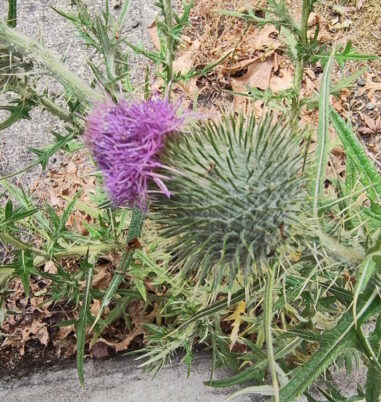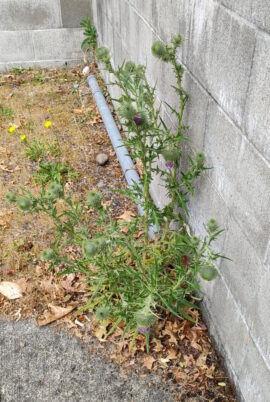Oh, You Teasel!

By Marcia Wilson
Part 1: It’s that spine of the year
“It’s that spine of the year”—Green Deane
The first of the thistles showed itself on the Lakewood Campus in late May. This fascinating member of the Aster Family possesses a rich and complex history with multiple cultures—and cuisines—across the globe. It is well worth getting to know.
Thistles exist in various incarnations from backyard weed to expensive seasonal cultivar. They have been grown by man for thousands of years, and they have been just as good at growing themselves. One mature bull thistle, for example, can produce millions of viable seeds. This is not the only reason why the non-native species are invasive: they are also aggressive, can spread quickly, and create shade that lowers the conditions for native plants.
A thorny problem
“…in reality, native thistles are benign and valuable plants that fill a variety of significant niches along more esteemed wildflowers such as coneflowers, prairie clovers, and others. While so many of those native wildflowers have been embraced by restoration practitioners, gardeners, and native plant enthusiasts, native thistles haven’t garnered the same enthusiasm, and that’s too bad. With sublime blue-green foliage, interesting stem and leaf architecture, and pink blossoms, our native thistles are every bit as resplendent—and as valuable for wildlife—as countless other native plants. It is time to change our attitudes towards our native thistles and recognize their importance, and the first step to do this is by providing the information for conservation practitioners to plant, protect, and grow these important native plants.”—Xerces Society
Welcome or not, thistles thrive. This country has 62 species on the native list, and it is worth learning about the natives as much as the non-natives if one is to really understand how to nurture the friend, and control the enemy.
A wanderer supreme, have been grown for the table for thousands of years. It is thanks to the skills of North African cultivars that we use the word artichoke, from the Arabic al-hursufa instead of the Latin Cirsium.
How that Bull Thistle growing behind Building 15 got here is simple enough: the non-natives arrived through its thin, silky seeds inside packaging and other containers packed for delicates like china and glass. The natives are diminished by their stronger approach, but remain strong and successful in their own right. This is because both species thrive in disturbed soils in sun-exposed areas. Not many plants can take the harsh extremes, but thistles are as tough as they look; perhaps even tougher.

Who is a tease?
Tease in English means to annoy, and it is an outgrowth from the Middle English tesen, which means pull apart, pick apart or scratch. To this day, a person who ‘rubs someone the wrong way’ is told not to tease. The prickly, flexible teasel heads of thistles were used for hundreds of years to ‘tease’ fabrics to encourage the development of fluff. Fluffy fabric was much warmer because it trapped air pockets.
A synonym for tease, heckle, has a very similar meaning. The point is, the thistle is associated with something annoying, but not necessarily evil; it may even be for the good.
Astonishingly, thistles were aggressively bred and cultivated for teasing fabric around 1800. While it soon died out from the sheer logistics of all the work building and maintaining the equipment, it operated on easily-replicated principles and was advantageous for its time.
In the common public eye, the thistle is the emblem for Scotland, which is also the world’s oldest nationally-recognized flower for a country. The former country’s motto plugs directly into the plant’s painful defense, with ‘no one provokes me with impunity.’ The plant has stout defenses against all but the most deliberate contact.
Thistles, it’s what’s for dinner
“All thistles are edible, but some are more edible than others”
—common forager’s complaint.

The Native Americans had a select variety of thistle native to Washington State. Its edibility is beyond a doubt; it is the Cirsium. edule. This thistle is often confused for the invasive species, but it is considered palatable and nurturing. The chosen parts of the plant are its young shoots, and the slightly-sweet roots. Be aware that these roots are sweet because they contain inulin, which can complicate some pre-existing health conditions in humans. The Native American’s use is not dissimilar to its use as a food among the rural Europeans; Italian-Americans often relied on the family Nonna to teach the new generation how to find, choose, and harvest common thistles for the table.
Next: Oh, you Teasel, Part 2: blessings, ethical solutions, and disorganized crime